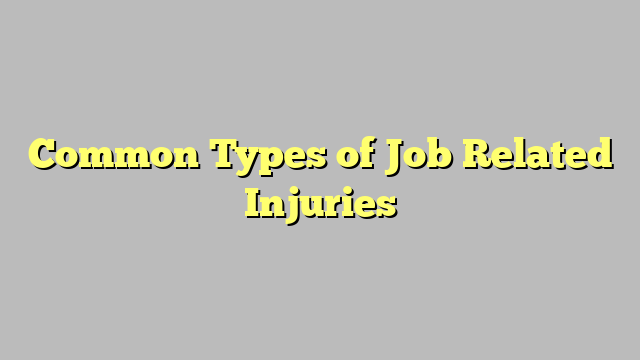Common Types of Job Related Injuries
Job-related injuries are a significant concern for both employees and employers across various industries. These injuries not only affect the health and well-being of workers but also have a considerable impact on productivity and overall workplace morale. Understanding the common types of job-related injuries, their prevalence, and strategies for prevention can empower individuals and organizations to create a safer work environment.
Common Types of Job-Related Injuries
Job-related injuries can manifest in numerous ways, depending on the nature of the work and the environment in which it takes place. Some of the most prevalent types include:
- Sprains and Strains: Often caused by lifting heavy objects or repetitive movements, sprains and strains are among the most common workplace injuries.
- Slip and Fall Injuries: Wet floors, uneven surfaces, and clutter can lead to slips and falls, which are frequent causes of injury in many workplaces.
- Repetitive Motion Injuries: These injuries occur due to repetitive tasks, such as typing or assembly line work, leading to conditions like carpal tunnel syndrome.
- Cuts and Lacerations: Employees working with sharp tools or machinery may be at risk of cuts, which can vary from minor to severe.
- Workplace Violence: Unfortunately, some workers may experience physical altercations or threats, leading to injuries that can have both physical and psychological effects.
Statistics on Workplace Injuries
Understanding the scope of job-related injuries is crucial. Statistics reveal that millions of workers are affected by workplace injuries each year. While many injuries are minor, others can lead to long-term disabilities or even fatalities. These statistics highlight the importance of implementing effective safety measures. According to data, industries like construction, healthcare, and manufacturing often report higher rates of workplace injuries, showcasing the need for targeted prevention strategies.
Prevention Strategies for Employees and Employers
Preventing job-related injuries requires a collaborative effort between employees and employers. Here are several strategies that can be implemented:
- Training and Education: Regular training sessions on safety protocols, proper equipment usage, and emergency procedures can significantly reduce the risk of injuries.
- Proper Ergonomics: Employers should promote ergonomic practices to minimize strain, especially for workers engaged in repetitive tasks.
- Regular Maintenance: Ensuring that equipment and workspaces are well-maintained can help prevent accidents related to faulty machinery or unsafe conditions.
- Encouraging Reporting: Cultivating a culture where employees feel comfortable reporting unsafe conditions or near misses can lead to proactive safety improvements.
- Personal Protective Equipment (PPE): Providing necessary PPE, such as gloves, helmets, and safety glasses, is essential in protecting workers from potential hazards.
Legal Rights and Workers’ Compensation
In the event of a job-related injury, it is vital for employees to know their legal rights. Most workers are entitled to workers’ compensation, which can cover medical expenses and lost wages due to injuries sustained on the job. The workers’ compensation process typically involves notifying the employer about the injury, seeking medical attention, and filing a claim. It is important for workers to keep detailed records of their injuries and any medical treatment received, as this documentation can be critical when filing a claim.
Employers are also encouraged to familiarize themselves with workers’ compensation laws to ensure they comply with regulations and provide necessary support to injured employees. For more information about workers’ compensation, particularly in specialized fields like landscaping and gardening, resources are available to guide both employers and employees through the process.
Steps to Take After a Job-Related Injury
If a job-related injury occurs, there are several steps individuals should take to protect their health and rights:
- Seek Medical Attention: The first priority should be to get appropriate medical care, even for seemingly minor injuries.
- Notify Your Employer: Report the injury to your supervisor as soon as possible to ensure that proper procedures are followed.
- Document Everything: Keep records of the incident, including details about how the injury occurred, witnesses, and medical treatment.
- File a Claim: Follow the necessary steps to file a workers’ compensation claim to receive benefits for medical expenses and lost wages.
- Follow Up: Stay in touch with your employer and healthcare provider to monitor recovery and return-to-work plans.
Understanding job-related injuries is essential for fostering a safe work environment and ensuring that employees are equipped with the knowledge they need to protect themselves. By implementing prevention strategies and being aware of legal rights, both employees and employers can work together to minimize the risks associated with workplace injuries.
